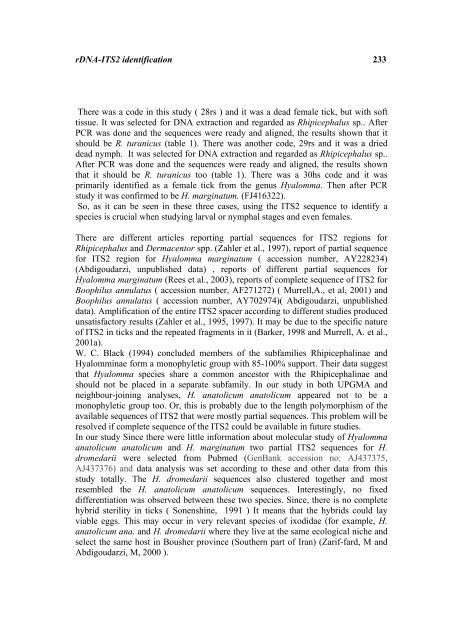rDNA-ITS2 Identification of Hyalomma, Rhipicephalus ... - HIKARI Ltd
rDNA-ITS2 Identification of Hyalomma, Rhipicephalus ... - HIKARI Ltd
rDNA-ITS2 Identification of Hyalomma, Rhipicephalus ... - HIKARI Ltd
You also want an ePaper? Increase the reach of your titles
YUMPU automatically turns print PDFs into web optimized ePapers that Google loves.
DNA-<strong>ITS2</strong> identification 233<br />
There was a code in this study ( 28rs ) and it was a dead female tick, but with s<strong>of</strong>t<br />
tissue. It was selected for DNA extraction and regarded as <strong>Rhipicephalus</strong> sp.. After<br />
PCR was done and the sequences were ready and aligned, the results shown that it<br />
should be R. turanicus (table 1). There was another code, 29rs and it was a dried<br />
dead nymph. It was selected for DNA extraction and regarded as <strong>Rhipicephalus</strong> sp..<br />
After PCR was done and the sequences were ready and aligned, the results shown<br />
that it should be R. turanicus too (table 1). There was a 30hs code and it was<br />
primarily identified as a female tick from the genus <strong>Hyalomma</strong>. Then after PCR<br />
study it was confirmed to be H. marginatum. (FJ416322).<br />
So, as it can be seen in these three cases, using the <strong>ITS2</strong> sequence to identify a<br />
species is crucial when studying larval or nymphal stages and even females.<br />
There are different articles reporting partial sequences for <strong>ITS2</strong> regions for<br />
<strong>Rhipicephalus</strong> and Dermacentor spp. (Zahler et al., 1997), report <strong>of</strong> partial sequence<br />
for <strong>ITS2</strong> region for <strong>Hyalomma</strong> marginatum ( accession number, AY228234)<br />
(Abdigoudarzi, unpublished data) , reports <strong>of</strong> different partial sequences for<br />
<strong>Hyalomma</strong> marginatum (Rees et al., 2003), reports <strong>of</strong> complete sequence <strong>of</strong> <strong>ITS2</strong> for<br />
Boophilus annulatus ( accession number, AF271272) ( Murrell,A., et al, 2001) and<br />
Boophilus annulatus ( accession number, AY702974)( Abdigoudarzi, unpublished<br />
data). Amplification <strong>of</strong> the entire <strong>ITS2</strong> spacer according to different studies produced<br />
unsatisfactory results (Zahler et al., 1995, 1997). It may be due to the specific nature<br />
<strong>of</strong> <strong>ITS2</strong> in ticks and the repeated fragments in it (Barker, 1998 and Murrell, A. et al.,<br />
2001a).<br />
W. C. Black (1994) concluded members <strong>of</strong> the subfamilies Rhipicephalinae and<br />
Hyalomminae form a monophyletic group with 85-100% support. Their data suggest<br />
that <strong>Hyalomma</strong> species share a common ancestor with the Rhipicephalinae and<br />
should not be placed in a separate subfamily. In our study in both UPGMA and<br />
neighbour-joining analyses, H. anatolicum anatolicum appeared not to be a<br />
monophyletic group too. Or, this is probably due to the length polymorphism <strong>of</strong> the<br />
available sequences <strong>of</strong> <strong>ITS2</strong> that were mostly partial sequences. This problem will be<br />
resolved if complete sequence <strong>of</strong> the <strong>ITS2</strong> could be available in future studies.<br />
In our study Since there were little information about molecular study <strong>of</strong> <strong>Hyalomma</strong><br />
anatolicum anatolicum and H. marginatum two partial <strong>ITS2</strong> sequences for H.<br />
dromedarii were selected from Pubmed (GenBank accession no: AJ437375,<br />
AJ437376) and data analysis was set according to these and other data from this<br />
study totally. The H. dromedarii sequences also clustered together and most<br />
resembled the H. anatolicum anatolicum sequences. Interestingly, no fixed<br />
differentiation was observed between these two species. Since, there is no complete<br />
hybrid sterility in ticks ( Sonenshine, 1991 ) It means that the hybrids could lay<br />
viable eggs. This may occur in very relevant species <strong>of</strong> ixodidae (for example, H.<br />
anatolicum ana. and H. dromedarii where they live at the same ecological niche and<br />
select the same host in Bousher province (Southern part <strong>of</strong> Iran) (Zarif-fard, M and<br />
Abdigoudarzi, M, 2000 ).
















